|
Smart Growth - or is it?
By Curtis Drake
Does anyone care about community character? We consider personal character to be valuable, how about community character? What attributes do you think about when you consider the character of various portions of our city? Would you like to live there? Why or why not? Are cultural characteristics less important than aesthetic characteristics? Is the historic character of a mature tree-lined street with graceful homes dismissed as warm and fuzzy and of lesser value when we are considering developing guidelines based on seemingly weightier issues of global warming and energy? Change is certainly inevitable, all cities evolve, the question is: How can we evolve without sacrificing community character, those good places, on the altar of economic or environmental pragmatism that can threaten the community character of our urban residential communities?
A hundred years ago the problem with many cities was urban tenements, city congestion, crime, industrial pollution, and sanitation. In the early 1900's George Marston used his Smokestacks vs Geraniums platform to direct the emerging community character of this small coastal town and attempted to avoid the industrial problems that plagued so many cities while promoting a natural and attractive environment. San Diego was still a new town developing, but the vision for the right character is as important today as it was then. Today, many cities are concerned with urban sprawl and the effects of deteriorating conditions in the once vibrant urban centers. Most larger cities have rediscovered, more or less, the value of a downtown historic district and have endeavored to reclaim some of the community character of the distant past by adaptive reuse of historic buildings. For example, San Diego has successfully reclaimed community interest in not only the downtown Gaslamp Quarter but also in various communities such as South Park, North Park, and Mission Hills, just to name a few.
Character is much easier kept than recovered. - Thomas Paine
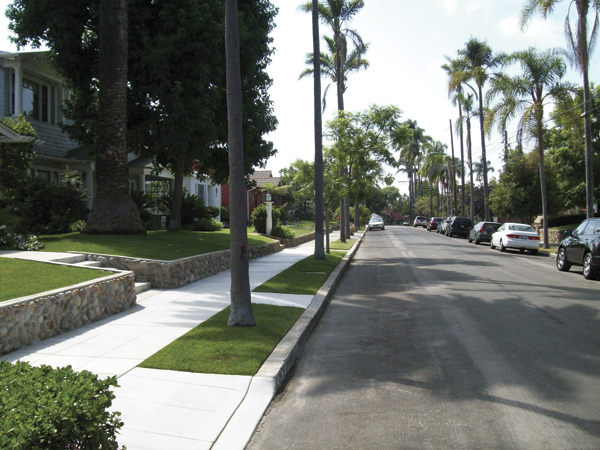
View of an early 1900s Mission Hills residential street with modest homes set back from the street. Photo by Curtis Drake
|
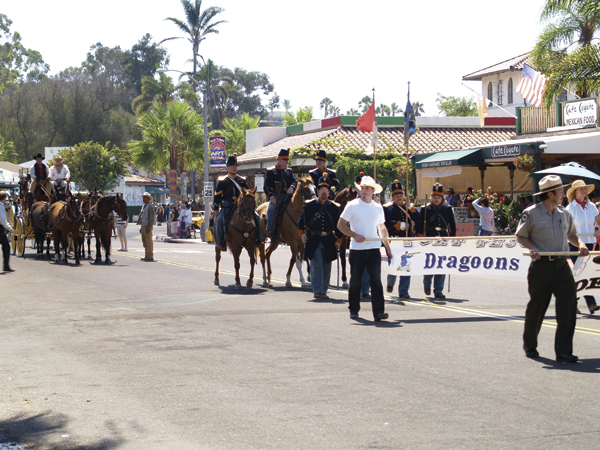
Cultural activities can be as important in shaping our experience as the built environment. Photo by Sandé Lollis
|
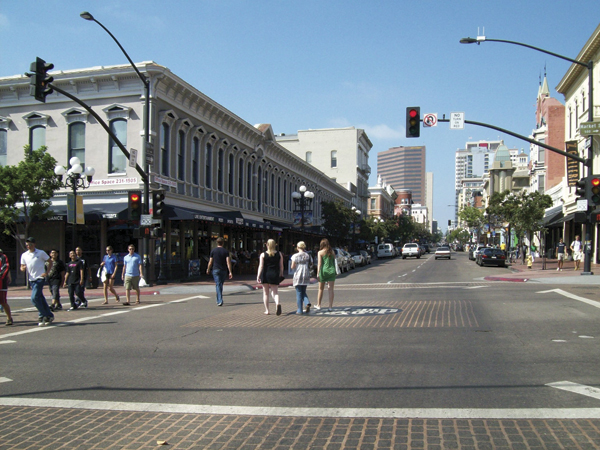
The rediscovery of the Gaslamp Quarter is where the value of a historic district is appreciated every day. Photo by Curtis Drake
|
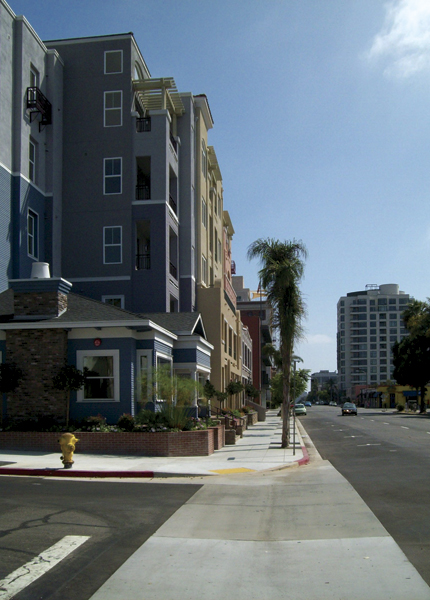
A high density development in Uptown partially swallows a bungalow and illustrates the future of many urban neighborhoods. Photo by Curt Drake
|
However, the economic and environmental benefits of increased density of urbanized areas and physical geographic features (mountains, beaches, and canyons) limit outward growth and have applied increasing pressures to existing urban residential neighborhoods. The Building Industry Association (BIA) is aiming squarely at urban infill for the future of most upcoming residential development. Even more focused is SB 375, a state transportation and land use bill, that has recently cleared the State Senate and is heading for the Governor's approval, which will initiate a historic rewrite of local planning laws, combining (for the first time) the issues of urban growth and global warming. Though the bill claims to protect historic sites, it will radically affect the historic protections of the California Environmental Quality Act (CEQA) and will provide substantial incentives to developers to redevelop urban sites by gaining new exemptions from CEQA. Many historically valuable structures are not "designated" and the community character which is often a compilation of numerous buildings are not considered "historic", therefore the "historic protections" of SB 375 may not apply to them. These pressures threaten to radically change the community character that exists in urban residential areas more than any other area of the city.
The Value of Smart Growth
City planners across the country have been getting on board with the "smart growth" principles supported by the American Institute of Architects (AIA), the United States Green Building Council (USGBC) and the Smart Growth Network. Who can argue with reviving our urban fabric and curtailing suburban sprawl? The Smart Growth Network recognizes that "smart growth" is more than curbing sprawl and shortening commutes. The Smart Growth Network principles include Community Quality of Life, which specifically addresses "preserving a sense of place" in their following statement: "But there is no 'one-size-fits-all' solution. Successful communities do tend to have one thing in common - a vision of where they want to go and of what things they value in their community - and their plans for development reflect these values." - Smart Growth Online (smartgrowth.org). Preservationists support community involvement and would hope this standard holds up when challenged by a developer who claims mandated density trumps Smart Growth's principles and whatever a community has identified as valuable.
Smart Growth - SB375 can be a Problem
But the AIA, USGBC, and Smart Growth Network, and now SB 375 are focused on the character of new projects with little emphasis on the reuse and retention of older buildings as a strategy in preserving community character. Adaptive reuse of older buildings is an effective tool for responsible, sustainable stewardship of our environment. This concept is called "embodied energy" and removing a building results in the waste of the embodied energy as well as the loss of a resource that may contribute to the character of the community. Sometimes an older remodeled building is actually concealing a building of great community character. In the fervor of the sustainable redevelopment, stoked by "incentives", there will be a lot of pressure to ignore the value of existing buildings or places and conveniently assume nothing can be done to adaptively reuse the building for the developer's predetermined purpose and get it out of the way. The larger the project, the more likely existing structures will be removed, and you can count on mandated density to breed large projects.
San Diego has 43 active Community Planning Groups (CPG's) that have their role in reviewing projects coming before the City Planning Commission and Historical Resources Board (HRB). In addition, Save Our Heritage Organisation (SOHO) and other interested parties are involved when a historic resource is involved in the scope of a project. So, you may say: "San Diego has a system in place that will safeguard the character of our communities, right?" Well, state-mandated guidelines, private property rights, aesthetics, economics, politics, and the courts can individually or together influence value choices. In spite of the 'system' we have seen plenty of unwelcome changes to our neighborhoods. Inappropriate sized homes, cheaply built condominium/apartment complexes, and commercial buildings with non-existent character replacing historic homes. It is hard to predict the outcome of "smart growth" or SB 375 politics. Sometimes nice sounding policies get a life of their own. City planners will be under a great deal of pressure by developers to rezone and allow significantly greater densities in older areas. Ironically, the CEQA that once protected historic buildings could be trumped by another environmental regulation (SB 375).
Indeed, there are plenty of changes ahead that could threaten our community character. We need to stay alert and work together with Community Planning Groups and City Planners to recognize what is valuable and identify what needs to be preserved. We must support and encourage our City Planners to be critical about the loss of our built heritage and require developers to creatively re-use valuable resources while meeting mandates. Certainly we should pursue the principles of sustainability and "smart growth" as we shape the future of our urban neighborhoods, but let us not loose sight of those special places that move our spirit and enhance our lives. Community character rooted in the historical built environment is our connection to the past, giving us relevance for the future.
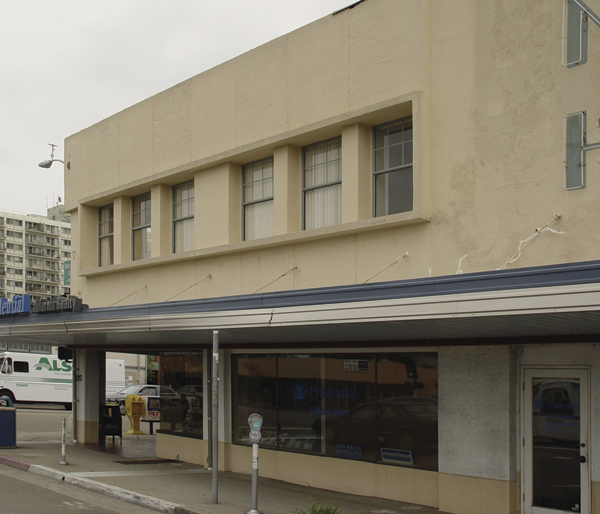 | 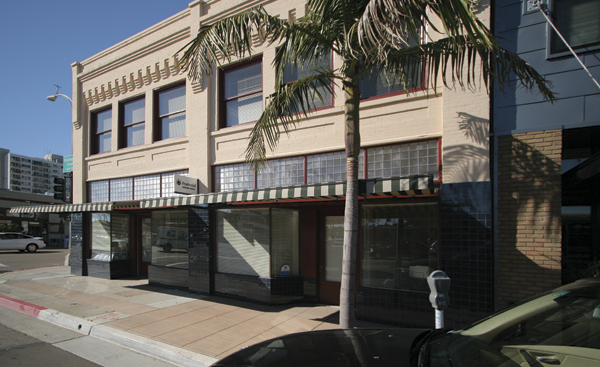 |
left This mid-century façade remodel hides the historic building underneath; right Same view, the character of the historic building could easily have been missed or lost, but was recently exposed as part of the Paseo de Mission Hills project. Photos courtesy Heritage Architecture
Curtis Drake is a principle with Heritage Architecture, one of the leading preservation architecture firms in the western United States. Curt is currently serving as President of SOHO.
|
MORE FROM THIS ISSUE
From the Editor
2008 Most Endangered List of Historic Resources
Character Matters
Smart Growth - or is it?
The Impact of Historic Districts
Washington Didn't Sleep Here
How to Research Your House
Preserving Community Character
Behind the Tuscany Craze
2008 People In Preservation Award Winners
Preservation Community
Reflections
Annual Financial Report
Book Review - Working Windows
Sherlock Homes
Speakers Bureau Forming
Lost San Diego
Strength in Numbers
Advertisements
DOWNLOAD full magazine as pdf (16mb)
|









